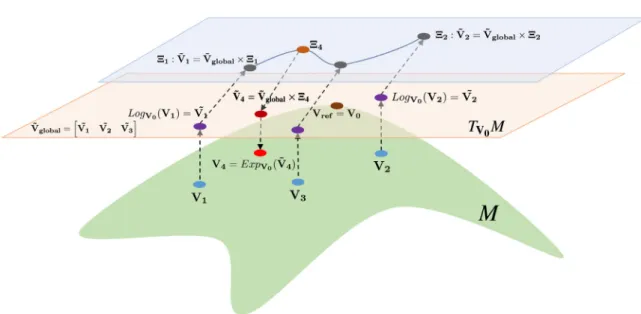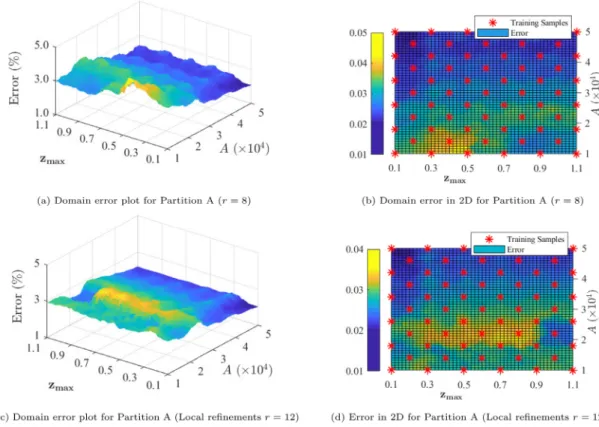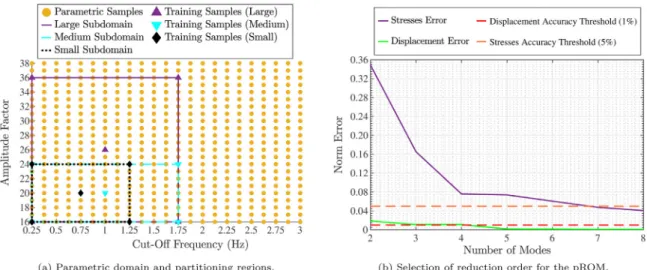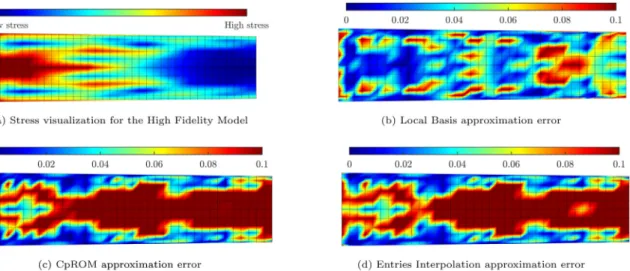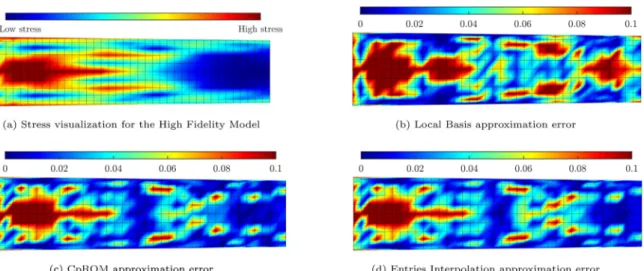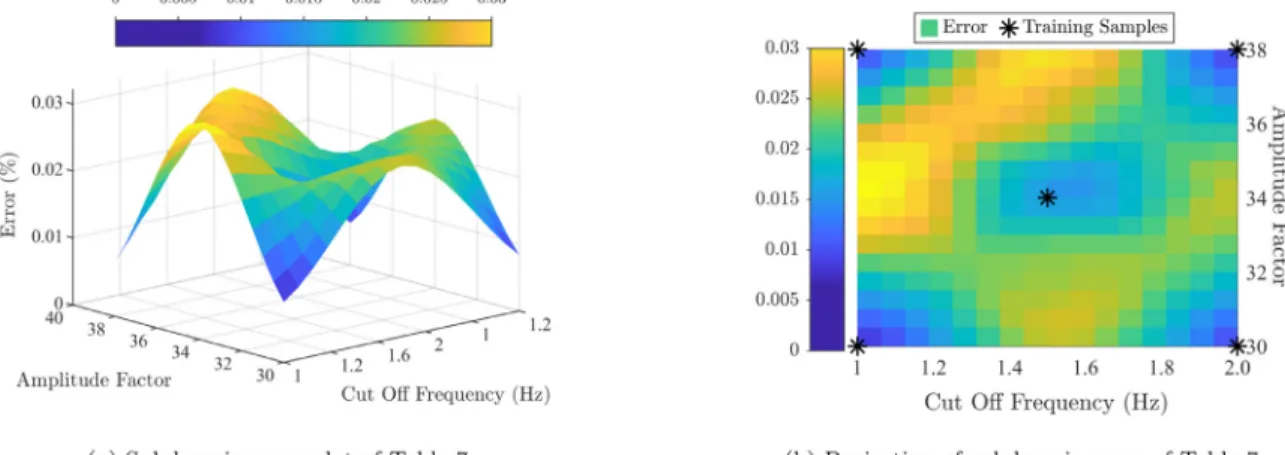Research Collection
Journal Article
A local basis approximation approach for nonlinear parametric model order reduction
Author(s):
Vlachas, Konstantinos; Tatsis, Konstantinos; Agathos, Konstantinos; Brink, Adam R.; Chatzi, Eleni Publication Date:
2021-06-23 Permanent Link:
https://doi.org/10.3929/ethz-b-000477997
Originally published in:
Journal of Sound and Vibration 502, http://doi.org/10.1016/j.jsv.2021.116055
Rights / License:
Creative Commons Attribution-NonCommercial-NoDerivatives 4.0 International
This page was generated automatically upon download from the ETH Zurich Research Collection. For more information please consult the Terms of use.
ETH Library
ContentslistsavailableatScienceDirect
Journal of Sound and Vibration
journalhomepage:www.elsevier.com/locate/jsv
A local basis approximation approach for nonlinear parametric model order reduction
Konstantinos Vlachasa,∗,Konstantinos Tatsisa, Konstantinos Agathosb, Adam R.Brinkc, Eleni Chatzia
aDepartment of Civil, Environmental and Geomatic Engineering, ETH Zurich, Stefano-Franscini-Platz-5, Zurich, 8093, Switzerland
bCollege of Engineering, Mathematics and Physical Sciences, University of Exeter, Exeter, United Kingdom
cSolid Mechanics, Sandia National Laboratories, Albuquerque, New Mexico
a rt i c l e i nf o
Article history:
Received 16 March 2020 Revised 12 January 2021 Accepted 25 February 2021 Available online 26 February 2021 Keywords:
As-built as-deployed structures Parametric model order reduction (pMOR) Nonlinear reduction
Reduced bases interpolation
a b s t ra c t
Theefficientconditionassessmentofengineeredsystemsrequiresthecouplingofhighfi- delitymodelswithdataextractedfromthestateofthesystem‘as-is’.Inenablingthistask, thispaperimplementsaparametricModel OrderReduction (pMOR)schemefor nonlin- earstructuraldynamics,andtheparticularcaseofmaterialnonlinearity.Aphysics-based parametricrepresentationisdeveloped,incorporatingdependenciesonsystemproperties and/orexcitationcharacteristics.ThepMORformulationreliesonuseofaProperOrthog- onal Decompositionappliedtoaseriesofsnapshotsofthenonlineardynamicresponse.
Anewapproachtomanifoldinterpolationisproposed,withinterpolationtakingplaceon thereducedcoefficientmatrixmappinglocalbasestoaglobalone.Wedemonstratethe performanceofthisapproachfirstlyonthesimpleexampleofashear-framestructure,and secondlyonthemorecomplex3Dnumericalcasestudyofanwindturbinetowerunder aground motionexcitation. Parametricdependencepertainsto structural properties,as wellasthetemporalandspectralcharacteristicsoftheappliedexcitation.Thedeveloped parametricReducedOrderModel(pROM)canbeexploitedforanumberoftasksincluding monitoringanddiagnostics,controlofvibratingstructures,andresiduallifeestimationof criticalcomponents.
© 2021 The Authors. Published by Elsevier Ltd.
ThisisanopenaccessarticleundertheCCBY-NC-NDlicense (http://creativecommons.org/licenses/by-nc-nd/4.0/)
1. Introduction
The emergenceofdigital twinsasamain enablerforvirtualization mandatesthecouplingofhighfidelitysimulations with data extracted frommonitored systems [62]. A ‘twin’ of an operating systemaims atprecise representationof its responseacrosstherangeofthesystem’sregularandextremeloadingconditions.Thisallowsforrobustdesignandeffective diagnosticsunderuncertainty[36,43].However,increasedsimulationaccuracyrequiresahigherdemandoncomputational
∗Corresponding author.
E-mail addresses: vlachas@ibk.baug.ethz.ch (K. Vlachas), K.Agathos@exeter.ac.uk (K. Agathos), arbrink@sandia.gov (A.R. Brink), chatzi@ibk.baug.ethz.ch (E.
Chatzi).
https://doi.org/10.1016/j.jsv.2021.116055
0022-460X/© 2021 The Authors. Published by Elsevier Ltd. This is an open access article under the CC BY-NC-ND license ( http://creativecommons.org/licenses/by-nc-nd/4.0/ )
resources, oftencompromisingefficiency.Forexample,models that cancapturelocal phenomenarequiretheinclusion of higher-end detail duringthe modeling stage, which leads to complex numericalrepresentations. To alleviate the burden ofcomputation, a trade-off betweenaccuracy andefficiency- tailoredtotheneeds oftheimplementation- isneeded. A means formaintaining accuracy liesin imprinting theunderlying physics intothe numericalrepresentation. Efficiencyis tackledbyderiving low-dimensionalmodels,whicharecapableofrapidcomputation,whilesufficientlyapproximatingthe underlying highfidelity representation[16,17]. Thisnotionis referred to asModelOrderReduction andthederived low- dimensional model as Reduced OrderModel (MOR andROM respectively). For the sake of simplicity the ROM acronym is used throughoutthispaper toindicate the Reduced OrderModeland MOR fortheprocess ofModel OrderReduction respectively.
TheavailableMORliteraturespansfromworksinthedomainsoffluiddynamics[12]andbiomedicalengineering[47],to thefieldsoffracturemechanics[37],structuraldynamics[5],monitoringandstateestimation[59]inamorecivilengineer- ingorientedperspective.Dependingonthedomainofimplementationandonthenaturalcomplexityoftheaddressedprob- lem (linear,nonlinear,orchaotic),severalapproachesandmethodologieshavebeenproposed. Acomprehensiveoverview, servingasaninitialbasis,maybefoundintheworksof[17]and[9].Besselinketal.[18]furtherofferareviewandcross- comparisonofestablishedMORtechniquesacrossscientific disciplines,includingstructuraldynamics,control, andapplied mathematics.
Under deterministicallyprescribed loadsandsystemproperties,a singleevaluationoftheROM atan examplesample representsaspecificinstanceofthephysicalsystemunderstudy.Inthiscase,theROMmayonlyreliablydescribethesys- tem’sresponseforagivenconfigurationandaroundanarrowrangeofsystemparameters.Ingeneralizingtheapplicability ofthe ROMformulation,it isnecessarytoexpressthedelivered representationintermsoftheparameters thatenter the governingequations.ThisgeneralizationisachievedviatheadoptionofparametricReducedOrderModels(pROMs)[16].A dynamicpROM,inparticular,shouldallowadequateapproximationofthedynamicsofthehighfidelitysystemthroughout therangeofinterestofmodelingparameters.
AssumingavailabilityofaHighFidelityModel(HFM)ofthesystemunderstudy,thederivationofaROMwithparametric dependency usually requires querying thisrepresentation over multipleparametric inputs. An extensive overviewof this class of intrusivemethods can be foundin [16,17]. Inthe samecontext, data-driven andindirect,non intrusivemethods havealsobeenproposed.Althoughthisextendsbeyondthefocusofthispaper,theinterestedreaderisencouragedtorefer to[45] forareviewonnon intrusivemethodsandto[33]forsuitable techniquesto addressnonlinearity.Regardingdata- drivenmethods,[50]canbetreatedasastartingpointreview.
AlthoughseveralapproachesforpROMsdoexist,notallofthemaresuitableforreproducingthetime-domainresponse andtheunderlyingphysicsofparametric,highorder,nonlineardynamicalsystems,representedbyFiniteElement(FE)mod- els.Anoverviewofrelevantliterature[16,17,41],revealstheProperOrthogonalDecomposition(POD-[23])asthedominant reduction method forthis class ofproblems. A shortintroductory review on the POD methodfor MOR can be found in [41].ThePODtechniquereliesondecompositionoftime-seriesresponsedatafromtrainingconfigurationsofthesystemin ordertoidentifyabasisforasubspaceoflowerdimensions,wheretheresponseliesandwheresolutionsaresoughtduring thevalidationphaseofthemethod.Since,typically,thissubspaceisofamuchlowerdimensionthantheHFM,thisallows to greatly reduce thesize ofthe problem.In principle thisresponsecould be obtainedfromeither simulatedoractually measureddata.Inthelattercaseadirectlinkisofferedonfusionofstructuralmodelswithmonitoringdataextractedfrom operatingstructures.
The POD approachis normallycoupledwith projection-basedreduction methodologies[17].Forexample, aglobalre- duction basis maybeassembled fortheentireparametric domain,whichseems tobe themethod ofchoicewhen linear problemsare addressed[5].In[2]cracked,twodimensionalsolidsareparameterizedwithrespecttothegeometric prop- ertiesofthecrack.ThepROMisshowntoefficientlyapproximatethestaticresponse forcracksthat donotliewithin the trainingset.Inthesamecontext,[25]proposeanadaptivetechnique,wherethepROMisembeddedwithinanoptimization process regardingthenumberoffull ordermodelevaluations.Similarconsiderations onreducingthe requirednumberof thetrainingsamplesarediscussedin[39].Theglobalapproachmaybeoffurtherusewhenthephenomenaunderconsid- eration are oflocalizednature.In thedomain offracturemechanics forinstance,[38] proposed a ROMbasedon domain partitioning,focusing thenumericalefforton thelocaldomainofthe defect.Thestructure domainispartitioned andre- ducedexceptforthelocalizeddomainofnonlinearitywherethefullmodelisevaluated.
Theglobalapproachmighthoweveryieldinaccurateresultsorbecomecomputationallyinefficientfornonlinearsystems, wheretheresponseisstronglydependentontheinputcharacteristics[6,67].Thisimpliesthateachnewtrainingparametric configurationcontributessubstantiallynewinformationtothePODbasis.Toaddressthisissue,[4]assembledapooloflocal PODbasesinsteadofusingasingleglobalprojectionbasis.Thenotionoflocalityrefersto“neitherspacenortimeapriori, but to theregion of the manifoldwhere the solutionlies ata given parametric input ortime instance”[5]. In[3] local subspacesareassembledwithrespecttotheparametricdomainofinput,whereasin[6]withrespecttotime.
Toreproducetheresponseofthesysteminan‘unseen’configuration,interpolationtechniquesareemployed.In[4]the localprojection basesareinterpolateddirectly,withinterpolationperformedinthespacetangenttotheGrassmannman- ifold. Thisis done to ensurethe interpolated basesmaintainorthogonality properties.A recentstudydiscussing detailed aspectsofthisapproachisgivenin[68].Analternativeapproachhasbeenimplementedin[8,27,48],whereinterpolationof theprojectedROMmatricesisused.ThisisreferredtoasmatrixinterpolationandlinearparametricROMsareinterpolated eitherintheoriginaldomainorinthespacetangenttotheGrassmannmanifold[4],aftersome formofcoordinatetrans-
formation hasbeenapplied forconsistency purposes[8].In thiscontext,the studiedinterpolationschemesincludespline interpolation[27]orLagrangepolynomials[8].
Severalcontributionsacrossvariousscientificdisciplinesarebasedontheformertwolocalinterpolationnotions,namely matrixandlocalbasesinterpolation.In[5]forexample,localbasesarecombinedwithk-meansclustering-basedinterpola- tionalgorithms.Asimilarapproachisusedin[6]wherelocalityisdefinedwithrespecttotime andaclusteringapproach with a suitable errormetric for onlineupdating is implemented.In [32] Gaussian Processes andBayesian strategies are adopted to address the optimal samplingof parametric input vectors, whereas similar considerations on optimizingthe number oftraining sampleswhile using a localbases interpolation approach are madein [42,56,58]. A novelpMOR ap- proach,suitable forcontactinmultibodydynamicsissuggestedin[19].GlobalcontactshapesarederivedandthepROMis augmented toincreaseaccuracy.Multi-parametricapproximationsarediscussedin[61],whereROMsareusedtoestimate steady-stateflowsovercomplexparameterizedgeometries.Anotherimportantcontributionis[52]whereanimprovedselec- tionstrategy forthebasisvectorsspanningthesolutionsubspaceisproposed.In[15]acomparisonofinterpolation-based reduction techniquesin the context of material removalin elastic multibody systems is discussed.Further contributions spanacrossthedomainsofshapeanddesignoptimization[7],solidandcontactmechanics[11,64],constrainedoptimization problems[63],highlynonlinearfluid-structureinteractionproblems[10]orcouplingMORwithComponentModeSynthesis [40].
The mentioned MORmethods focus mainlyon identifyingbases, ableto representthe HFMsolutions over arange of parameters. However,amainlimitingfactorfortheperformanceofnonlinearprojection-basedROMs istheactualprojec- tion of the systemvectorsand matricescontainingnonlinear terms inthe reduced space[29,51]. Therefore, a necessary componentforformulatingcomputationallyefficientROMsforFE-basedformulationsliesintheuseoftechniquestoreduce thecomplexityofsuchprojections,collectivelyreferredtoashyper-reductiontechniques.Thesesecond-levelapproximation strategiestypicallyrelyonevaluatingthenecessaryprojectionsonalimited,appropriatelyselected,setofelementsintheFE mesh.MethodsofthiscategoryincludetheGaussNewtonwithApproximatedTensors(GNAT)methodpresentedin[21],the DiscreteEmpiricalInterpolationMethod(DEIM)suggestedin[24]andtheEnergy-ConservingSamplingandWeightinghyper reduction methodproposedin[29].Thecomputational efficiencyoftheseapproacheshasbeensuccessfullydemonstrated in [6,22,28,31,46].Based on theconsiderations madein[30] regarding numericalstability,structure preservingproperties andoverallefficiency,thispaperimplementstheECSWapproach.
This paper focuseson developmentand demonstration of a pROM schemefor approximation of the time history re- sponseofstructuralsystemsfeaturingmaterialnonlinearity,tiedtophenomenasuchasplasticityandhysteresis.Werefrain from exemplifyingourapproach ongeometric nonlinear problemssince we considerthese havebeendiscussed indetail in [29,30,44],adoptingsimilar reductionstrategiesto theone proposed here.The topicofmaterialnonlinearityhas been addressedinthecontextofthermalloadsforexamplein[66],orwithrespecttoimpactanalysis[29,58].Ourpaperaddsto thisliteraturebyimplementingapROM,abletomodelmaterialnonlinearityandaddressparametricdependencypertaining ineitherthesystemortheexcitationconfiguration.Specifically,wedemonstratetherelevantaspectsofparameterizationin termsofinfluencingstructuraltraits,suchasmaterialpropertiesandhysteresisparameters,aswellasintermsofparame- terizationofactingloads,e.g.earthquakes,inthetemporalandspectralsense.Moreover,weimplementavarianttechnique to the established localbases interpolationmethod inthe sense that the dependenceofa HFM onthe characteristics of theconfigurationand/orloadingparametersisexpressedonaseparate leveltothatofthesnapshotprocedure.Theresult- ing pROMallowsforacceleratedcomputation,whichisparticularlycriticalforapplicationsinmonitoringanddiagnostics, controlofvibratingstructures,andresiduallifeestimationofcriticalcomponents.
2. ProblemstatementandpROMformulation
Structural systems and components are exposed to harsh operating environments and adverse loading. The resulting dynamicscanbeofnonlinearnature,albeittypicallysimplisticallyapproximatedby lineardomainassumptions,whichare oftentimesinsufficient.Afurthercomplexityliesinthefactthatthedynamicsofreal-lifestructuralsystemsisdependenton material,geometrical,environmentalorloadingparameters.Therefore,whendesiredtoreliablyapproximatethedynamicsof an‘as-builtas-deployed’system,i.e.,ofasysteminitsoperatingstatetheaspectsofnonlinearityandparametricvariability needtobeefficientlytackled.Naturally,thisposesalimitingfactorfromthecomputationalpointofview,sincetheprecise approximationofasystemacrossthewholerangeofitsdefiningparameterswouldrequirehighfidelitysimulationsacross multiple realizations ofits defining parameter vector. Thisimpliesa high computationaltoll that prohibits adoptioninto practice, particularlyfor scenarios which necessitate a fastreaction, such as fault diagnosisand control. The aimof this work istoaddress theaccuratemodeling of‘asbuiltas-deployed’nonlineardynamicstructuralsystems(orcomponents).
Thetaskistodeliverasufficientreducedorderapproximationundervariabilityofthestructuralpropertiesoroftheacting loads.
Thissection offersashortoverviewofthebackgroundknowledgerequiredfortheformulationoftheproposed pROM.
Firstly,theaspectofparametricdependencyisvisitedbyprovidinganoverviewofexistingpROMformulations.Then,hyper- reduction isdiscussed asafurthernecessary reductionmethodforreducing theprohibitive computational tollassociated withlargedegreeoffreedomfiniteelementrepresentations.
2.1. POD-basedpROMsfornonlinearsystems
Thissubsectionpresentsthefundamentalbackgroundrequiredforthetreatmentofparametricdependencieswithinthe MORframework,whichservesasthebasisforestablishingaparametricreducedordermodel(pROM)formulationfornon- linearsystems.Withinthiscontext,anonlineardynamicalsystemwhoseconfigurationdependsonl parameters,contained intheparametervectorp=[p1,...,pl]T∈⊂Rl isconsidered.Thevibrationresponseofsuchsystemisdescribedbythe governingequationsofmotion
M(p)u¨(t)+g(u(t),u˙(t),p)=f(t,p), (2.1)
whereu(t)∈Rnrepresentsthesystemdisplacement,M(p)∈Rn×ndenotesthemassmatrix,f(t,p)∈Rnrepresentsthevec- tor of externally applied loads andn is the order of the system, which physically representsthe numberof degrees of freedom.Thenonlinearityofthesystemliesintherestoringforcetermg(u(t),u˙(t))∈Rn,whichrepresents the resisting or internalforcesofthesystemduetointernalstressesandstrainsandisfurtherdependent,alongwiththemassmatrixand theexternallyappliedexcitation,ontheparametervectorp.Thisdependencymayrepresentdifferentsystemconfigurations dependingonthetargetapplication,suchasdamagescenarios,whichmaybereflectedonthestiffnessand/ordampingand massmatrices,orvaryingboundaryconditions,whicharedictatedbytheexcitationvector.
The goalofparametricROMsisto generatean equivalentsystemofdimension r,such thatr<<nandtheunderlying physics along withthe parametric dependenciesof interestare further retained. Giventhe dependenceof thegoverning system equations, represented by Eq. (2.1), on the parameters p, the reduction step is herein performedfor a number of samplepointspj for j=1,2,...,N in the parameterspace usinga projection-based strategy. As such, thesolution of Eq. (2.1) fora certain parameter sample pj is attractedto a lower dimensional subspace S⊂Rn, spannedby the set of orthonormalbasisvectorsV(pj)=
v1(pj),v2(pj),...,vr(pj)
,accordingto
u(t)=V(pj)ur(t), (2.2)
where V(pj)∈Rn×r is calledthe projection basis and thereduced sizevector ur∈Rr definesthe components ofthe so- lution inthisbasis. Thereafter, the reduced-order representationofthe High Fidelity Model(HFM) isobtainedby means ofaGalerkinprojection,whichiscarriedoutby substitutingEq.(2.2) intoEq.(2.1),pre-multiplying withthetransposeof the projectionbasis V(pj)T andlastly imposing theorthogonalityconditionoftheoccurringresiduals withrespectto the projectionbasis.Thisresultsinthefollowingsystemofequations:
Mr(pj)u¨r(t)+gr
u(t),u˙(t),pj
=fr(t,pj) (2.3)
where Mr(pj)∈Rr×r andgr
u(t),u˙(t),pj
∈Rr denote the reduced-order mass matrix and restoring force vector respec- tively,whilefr(t,pj)∈Rrdesignatesthegeneralizedvectorofexternalforces,asfollows
Mr(pj)=V(pj)TM(pj)V(pj) gr(pj)=V(pj)Tg
u(t),u˙(t),pj
fr(pj)=V(pj)Tf(t,pj) (2.4)
The computationoftheorthonormalbasis vectorsV(pj)=
v1(pj),v2(pj),...,vr(pj)
, whichisthekey elementof the reductionstep,istypicallycarriedoutbymeansofProperOrthogonalDecomposition(POD)[23].Assuch,apoolofdisplace- mentfieldsamplesiscollectedfromthetimehistoryanalysisoftheHFM.Eachoneofthepoolsisextractedfromaunique parameterconfigurationpj ofthefull ordermodel,whichishenceforthtermedassnapshot.Thereafter,theinformationof allsimulatedpoolsofsamples,orequivalentlysnapshots,iscollectedonaglobalbasisVfull,whichessentiallycapturesthe parametric dependenceofthemodel,since responseinformationacross theentireparameterspaceis assembledthrough sampling.ASingularValueDecomposition(SVD)islastlyappliedtoVfullinordertoobtaintheprincipalorthonormalcom- ponents ofthereductionbasis Vspanningthelowersubspace Softhesolution.Theerrormeasureusedin[31]isherein employed forthispurpose aswell. Thesesteps representtheoffline phaseof reduction,which producesthe globalSVD- basedprojectionbasis V.The lattermaybeutilizedforglobalsystemorderreduction,accordingtoEq.(2.4),withtheaim ofreflectingtheunderlyingdynamicsandthereforeapproximatingtheresponseofthemodelatunseenparametersamples.
Oneofthelimitationsofsuchanapproachliesonthefactthattheresponseofnonlinearsystemsisstronglydependent on the parameter values andmay be dominated by localized phenomena which are owed to the nonlinear terms. This impliesthattheresponsemaywelllieonspacesthatcannotbespannedbyasingleglobalbasis,unlessthelattercomprises a largenumberofbasisvectors. Asaresult,localizedfeaturesthat areobservedonlyinarestrictedparametersubdomain endup affecting anddetermining theoverall estimationcapabilitiesofthe ROM[67].To addresstheseissues,a different strategycanbeemployed,aswasinitiallyhighlightedinSection1.Insteadofformulatingaglobalprojectionbasis,apoolof localPODbasescanbeassembledduringtheofflinephase,witheachoneofthosebasescorrespondingtoauniquesample, orfamily ofparametersamples.Toreproduce thenthe responseof thesystemforan ‘unseen’configuration inan online manner,interpolationtechniquescanbeemployedwiththeaimofestimatingthelocalPODbasisattherequiredparameter pointandsubsequentlyobtainthereducedmatricesbasedonEq.(2.4).
